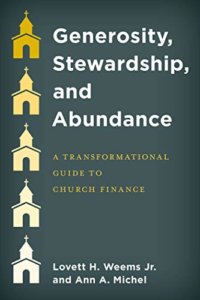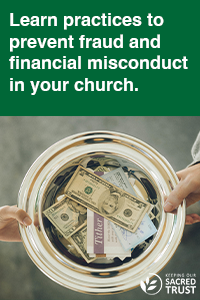How can congregations invite new givers to begin their journey of generosity? Ann Michel of the Lewis Center staff outlines seven strategies more likely to connect with newer, younger givers.
Comprehensive research on giving patterns among American Christians has revealed that one in five gives nothing to church or other charities. This might seem quite shocking, but it’s highly likely that the same pattern exists in your church. Congregations that study their own giving patterns typically discover that 20 to 30 percent of their members and participants are noncontributors.
Who is among this sizable cohort of nongivers? Some may be younger or new to the church without a clear understanding of why they should support the church. Some are your Easter and Christmas crowd. Others may be less active than they once were. Some think it doesn’t apply to them for whatever reason. And some just have never gotten with the program. But what all these people have in common is that our typical ways of inviting them to give don’t resonate. So, what can congregations do differently to invite new givers to begin their journey of generosity?
1. Adjust your attitude.
We have a tendency to think of nongivers as deadbeats or freeloaders and then base our appeals on guilt or obligation. This approach makes potential givers feel guilty, anxious, and unwelcome. Assume God has placed these people in the orbit of your church for a reason and that they just need a little extra encouragement to get started.
2. Stop talking about stewardship.
In many churches, the conversation around money and giving relies heavily on the vocabulary of stewardship and tithing. Stewardship and tithing are, of course, important elements of our theology of giving. But unfortunately, beyond a small audience of church insiders, few grasp the deeper meaning of these terms. And too often they are heard as thinly veiled euphemisms for church fundraising or finger-wagging legalisms. The vocabulary of gratitude and generosity can be a more gracious and inviting way to talk about giving and one that is equally faithful and biblical. It is a simpler, more relatable way to talk about the importance of giving.
3. Answer the “why” question.
Fewer and fewer people, even within our churches, have been taught the normative expectations of the faith regarding giving. Several key questions are relevant. Why do we give? How do we give? And how much do we give? But too often, our conversations jump immediate to “how much,” short circuiting the foundational question of “why.” We can’t logically expect someone to give away a sacrificial portion of what they have if they don’t yet understand why faith calls them to give. But don’t expect your nongivers to line up for the next Bible study on Christian giving. They are much more likely to absorb lessons about giving that are woven into the ongoing life of the church — in preaching, prayers, worship, and other aspects of congregational life.
4. Provide special giving opportunities.
Newer givers are often motivated by specific, tangible needs. They understand the importance of contributing $50 if it’s needed to fuel the van for the mission trip or $100 to purchase groceries for the food pantry. Such giving opportunities tell a story. They educate potential givers about the church’s mission and allow a new giver to experience the joy of contributing to something worthwhile. But the trick is to use these appeals strategically to educate and motivate new givers, while at the same time encouraging them toward regular ongoing gifts. For example, if someone contributes five jars of peanut butter for the food pantry, ask them next to give $50 to support the project, and later for a gift to the church, explaining how the food pantry is part of the church’s ongoing mission.
5. Build involvement.
The strongest predictor of how much someone gives is their level of activity and engagement, not their income. So, the best way to get people interested in giving is to get them actively involved. Invite that person who gave five jars of peanut butter to join the food ministry team, and they will start connecting the dots between giving to the church and this important work.
6. Use digital communication to invite people to give.
Nongiving members likely attend worship much less regularly than your more generous givers. And that’s a problem. Because most congregations only ask people to give when they show up on Sunday. Electronic giving has the potential to reach younger generations, occasional attenders, and even people who don’t yet attend church by leapfrogging beyond our traditional “place-based” giving appeals. But electronic giving works for churches that become skilled not only in receiving digital gifts but also in soliciting gifts through digital communication and social media. In the internet age, virtually all other nonprofits cultivate their donor base through electronic communication and electronic giving. And forward-thinking churches are taking a page from their playbook.
7. Ask for gifts not pledges.
People give before they pledge or tithe. If a pledge campaign is your primary vehicle for inviting people to give, your messages probably aren’t connecting with those who aren’t ready or willing to pledge. After all, why would someone who’s not giving a dime to the church pay attention when you ask them to give 10 percent? Pledges serve a very important purpose. But they are not the most likely on-ramp for new givers.
When conducting a stewardship campaign, instead of sending pledge cards to noncontributors, send them a letter asking for a gift. Remind them of the church’s good work and how they can be part of it. Yes, this means someone needs to be paying attention to who’s who, where they are spiritually, and what they give. But the need to communicate with people about their giving in meaningful and appropriate ways is one of the best arguments for paying attention to what people give.
 Ann Michel is co-author with Lovett H. Weems, Jr. of Generosity, Stewardship, and Abundance: A Transformational Guide to Church Finances (Rowman and Littlefield, 2021).
Ann Michel is co-author with Lovett H. Weems, Jr. of Generosity, Stewardship, and Abundance: A Transformational Guide to Church Finances (Rowman and Littlefield, 2021).
Related Resources
- A Gracious Invitation to Generosity by Ann A. Michel
- The Promise of Digital Giving by Ann A. Michel






